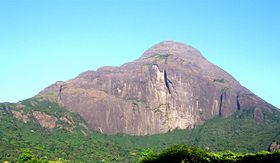
Back অগস্ত্য মালা Bengali/Bangla Agastyamalai Catalan Agastya Malai CEB Agastya Malai German Agastyamalai Spanish अगस्त्य मला Hindi ಅಗಸ್ತ್ಯ ಮಲೈ Kannada Agastya Mala LLD അഗസ്ത്യകൂടം Malayalam अगस्त्यमला शिखर Marathi
This article needs additional citations for verification. (June 2012) |
| Agastya Mala | |
|---|---|
 A view of Agastyaarkoodam from the base | |
| Highest point | |
| Elevation | 1,869 m (6,132 ft) |
| Prominence | 1,510 m (4,950 ft)[1] |
| Listing | Ultra, Ribu |
| Coordinates | 8°36′58.64″N 77°14′44.62″E / 8.6162889°N 77.2457278°E |
| Geography | |
Tamilnadu, India | |
| Parent range | Western Ghats |
Agastya Mala (or Agasthyamalai or Agastyarkoodam) is one of the peaks of the Agasthyamala Biosphere Reserve in the Western Ghats that lies between the districts of Tirunelveli District of Tamilnadu and Thiruvananthapuram District district of Kerala, India.[2] This peak is specifically located in the Thiruvananthapuram district of Kerala, near the Tamil Nadu border. It is 1,868-metres (6,129 ft) tall.[citation needed]. The perennial Thamirabarani River originates from the eastern side of the range and flows into the Tirunelveli district of Tamil Nadu. The rivers flowing westwards through the district of Thiruvananthapuram in Kerala are the Karamana River and the Neyyar river.
Agastyaarkoodam is a major trekking spot in the southern end of the Western Ghats. It is also considered as a pilgrimage spot for devotees of the Hindu sage Agastya, who is considered to be one of the seven rishis (Saptarishi) of Hindu Puranas. In Tamil traditions, Agastya is considered as the father of the Tamil language and the compiler of the first Tamil grammar called Agattiyam or Akattiyam.[3] There is a small stone statue of Agathiyar at the top of the peak where one can offer flowers as offerings to the mystical sage considered as a “Chiranjeevi” which means immortal.
Agasthyamala Biosphere Reserve is among 20 new sites added by UNESCO to its World Network of Biosphere Reserves in March 2016. The International Co-ordinating Council added the new sites during a two-day meeting on 19 March 2016 in Lima, bringing the total number of biosphere reserves to 669 sites in 120 countries, including 16 transboundary sites. The biosphere reserve includes close to 300 rare bird species and more than 200 medicinal plants endemic to this region.[4]
- ^ https://worldribus.org/indian-subcontinent/
- ^ Google Maps
- ^ [Richard S Weiss 2009, pp. 50–51, 81–82] and [Klaus Klostermaier (2003), A Concise Encyclopedia of Hinduism, Oxford: Oneworld Publications; ISBN 1-85168-175-2, page 17]
- ^ "UNESCO added Agasthya Mala to its World Network of Biosphere Reserves in 2016". The Economic Times. PTI. 21 March 2016. Retrieved 12 July 2016.
